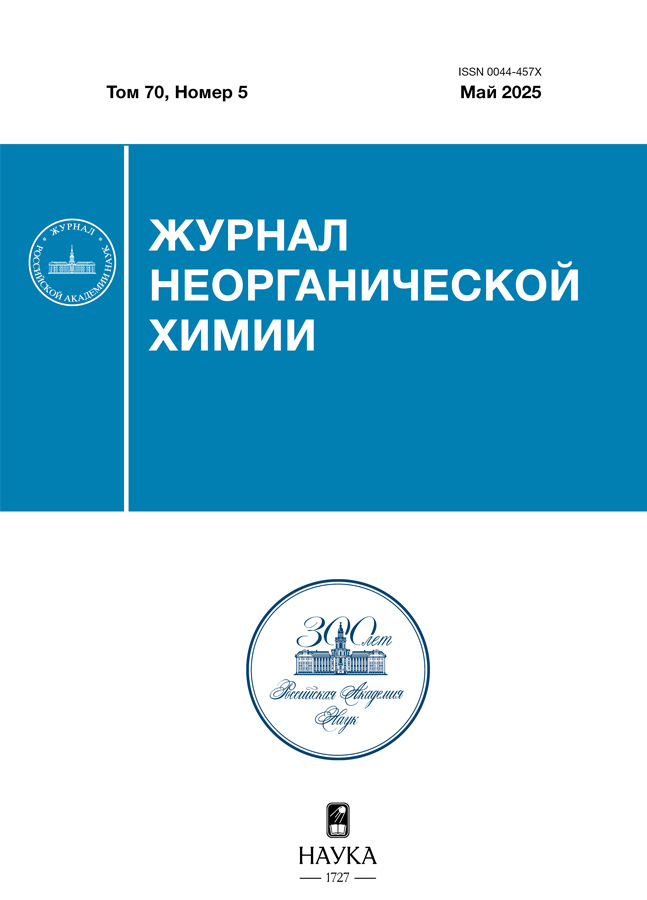Formation of sodium zirconium silicophosphate with the structure Na3Zr2Si2РO12 from a Zr-deficient precursor
- Авторлар: Grishchenko D.N.1, Medkov M.A.1
-
Мекемелер:
- Institute of Chemistry, Far East Branch of the Russian Academy of Sciences
- Шығарылым: Том 70, № 5 (2025)
- Беттер: 678-686
- Бөлім: СИНТЕЗ И СВОЙСТВА НЕОРГАНИЧЕСКИХ СОЕДИНЕНИЙ
- URL: https://rjmseer.com/0044-457X/article/view/685480
- DOI: https://doi.org/10.31857/S0044457X25050079
- EDN: https://elibrary.ru/HYECUN
- ID: 685480
Дәйексөз келтіру
Аннотация
Samples of NASICON glass-ceramics were synthesized by pyrolysis of a mixture of organic solutions in molten rosin. The article discusses the phase formation, morphology and characteristics of the obtained silicophosphates. The composition formed from the precursor with the molar ratio of components Na : Zr : Si : P equal to 3 : 1.33 : 2 : 1 was selected for study. The effect of additional amounts of phosphorus on the phase composition of the sample was studied. It was found that the precursor of the composition 3 : 1.33 : 2 : 1.15 forms densely sintered glass-ceramics containing a crystalline phase of the composition Na3Zr2Si2PO12. The composition of the product is confirmed by the unit cell parameters calculated by the Rietveld method. The samples were obtained at a temperature of 1000 and 1100°С without pressing and have densities of 85 and 88% of the theoretical value, respectively. It was concluded that Na, Si, P not included in the crystal lattice participate in the formation of the X-ray amorphous phase and provide conditions for the formation of NASICON by the type of liquid-phase sintering. A comparative characteristic of the properties of the Na3Zr2Si2PO12 composition obtained from Zr-deficient and non-deficient precursors was carried out. It is shown that the glass phase formed in the intergranular space of Zr-deficient samples negatively affects the conductivity values of the material.
Негізгі сөздер
Толық мәтін
Авторлар туралы
D. Grishchenko
Institute of Chemistry, Far East Branch of the Russian Academy of Sciences
Хат алмасуға жауапты Автор.
Email: grishchenko@ich.dvo.ru
Ресей, Vladivostok, 690022
M. Medkov
Institute of Chemistry, Far East Branch of the Russian Academy of Sciences
Email: grishchenko@ich.dvo.ru
Ресей, Vladivostok, 690022
Әдебиет тізімі
- Fergus J-W. // Solid State Ionics. 2012. V. 227. P. 102. https://doi.org/10.1016/j.ssi.2012.09.019
- Fuentes R.O., Marques F.M.B., Franco J.I. // Bol. Soc. Esp. Cerám. Vidrio. 1999. V. 38. № 6. P. 631.
- Ignaszak A., Pasierb P., Gajerski R., Komornicki S. // Thermochim. Acta. 2005. V. 426. № 1–2. P. 7. https://doi.org/10.1016/j.tca.2004.07.002
- Грищенко Д.Н., Курявый В.Г., Подгорбунский А.Б., Медков М.А. // Журн. неорган. химии. 2023. Т. 68. № 1. С. 17. https://doi.org/10.31857/S0044457X22601043
- Jalalian-Khakshour A., Phillips Ch., Jackson L. et al. // J. Mater. Sci. 2020. V. 55. P. 2291. https://doi.org/10.1007/s10853-019-04162-8
- Shimizu Y., Azuma Y., Michishita S. // J. Mater. Chem. 1997. V. 7. № 8. P. 1487.
- Zhang S., Quan B., Zhiyong Z. et al. // Mater. Lett. 2004. V. 58. № 1. P. 226. https://doi.org/10.1016/S0167-577X(03)00450-6
- Porkodi P., Yegnaraman V., Kamaraj P. et al. // Chem. Mater. 2008. V. 20. P. 6410. https://doi.org/10.1021/cm800208k
- Naqash S., Sebold D., Tietz F., Guillon O. // J. Am. Ceram. Soc. 2018. V. 102. № 3. P. 1057. https://doi.org/10.1111/jace.15988
- Naqash S., Ma Q., Tietz F., Guillon O. // Solid State Ionics. 2017. V. 302. P. 83. http://dx.doi.org/10.1016/j.ssi.2016.11.004
- Alpen U. V., Bell M.F., Höfer H.H. // Solid State Ionics. 1981. V. 3–4. P. 215. https://doi.org/10.1016/0167-2738(81)90085-0
- Susman S., Delbecq C.J., McMillan J.A., Roche M.F. // Solid State Ionics. 1983. V. 9–10. P. 667. https://doi.org/10.1016/0167-2738(83)90312-0
- Wang H., Zhao G., Wang S. et al. // Nanoscale. 2022. V. 14. № 3. P. 823. https://doi.org/10.1039/d1nr06959d
- Oh J.A.S., He L., Plewa A. et al. // ACS Appl. Mater. Interfaces. 2019. V. 11. P. 40125. https://doi.org/10.1021/acsami.9b14986
- Ji Y., Honma T., Komatsu T. // Materials. 2021. V. 14. № 14. P. 3790. https://doi.org/10.3390/ma14143790
- Narayanan S., Reid S., Butler S., Thangadurai V. // Solid State Ionics. 2019. V. 331. P. 22. https://doi.org/10.1016/j.ssi.2018.12.003
- Грищенко Д.Н., Подгорбунский А.Б., Медков М.А. // Журн. неорган. химии. 2024. Т. 69. № 2. С. 15. https://doi.org/10.31857/S0044457X24020025
- Rao Y.B., Bharathi K.K., Patro L.N. // Solid State Ionics. 2021. V. 366–367. P. 115671. https://doi.org/10.1016/j.ssi.2021.115671
- Грищенко Д.Н., Медков М.А. // Журн. неорган. химии. 2023. Т. 68. № 8. С. 1042. https://doi.org/10.31857/S0044457X23600366
- Bauerle J.E. // J. Phys. Chem. Solids. 1969. V. 30. P. 2657. https://doi.org/10.1016/0022-3697(69)90039-0
- Зарецкая Г.Н. // Современные наукоемкие технологии. 2007. № 6. С. 51. https://top-technologies.ru/ru/article/view?id=24998
- Соколов И.А., Мурин И.В., Крийт В.Е., Пронкин А.А. // Электрохимия. 2011. Т. 47. № 4. C. 436.
- Fuentes R.O., Figueiredo F.M., Marques F.M.B., Franco J.I. // Solid State Ionics. 2001. V. 140. № 1–2. P. 173. https://doi.org/10.1016/S0167-2738(01)00701-9
- Lee J. S., Chang C. M., Lee Y. I. et al. // J. Am. Ceram. Soc. 2004. V. 87. № 2. P. 305. https://doi.org/10.1111/j.1551-2916.2004.00305.x
- Suzuki K., Noi K., Hayashi A., Tatsumisago M. // Scripta Mater. 2018. V. 145. P. 67. https://doi.org/10.1016/j.scriptamat.2017.10.010
- Tang B. // Appl. Comput. Eng. 2024. V. 91. № 1. P. 89. https://doi.org/10.54254/2755-2721/91/20241079
Қосымша файлдар

















